Post by brillbilly on Aug 12, 2010 2:55:37 GMT 10
A Phoenician Fortress and Furnace?
by David Campbell
The discovery of the hilltop fortress and furnace came about, it seemed, by casual chance. My wife publishes a little community newspaper distributed in the counties bordering the Red River around Lake Texoma, called TGIF The Weekend Bandit. It is a general interest paper focusing mainly on local events and history. I write a weekly column on history and sometimes feature articles. Since I grew up near Rockwall, Texas, it was of great interest to me to discover that in January 2000 excavation of the mysterious buried wall there had finally been undertaken. I had been obsessed by that wall since childhood.
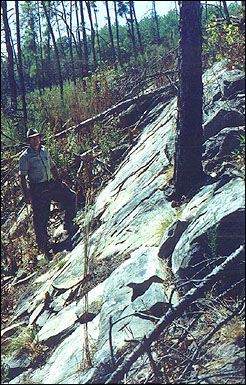
Only a week or two earlier, I had done an article on Gloria Farley's work on the Heavener Runestone. The rock wall seemed a logical follow up, especially since "runes" had been unearthed there in 1949. In the article, I asked any readers who knew of similar writings or walls to contact me. Following that, I gave a synopsis of Viewzone's expedition to the Purgatory River canyon.
The following Friday, my wife and I returned from our weekly 600 mile distribution route to find a somewhat urgent message from a reader in Colbert, Oklahoma. When I returned his call, he told me of meeting a man while he was hunting arrowheads in the Kiamichi Mountains. This man had found stone tablets with some kind of writing on them and seemed eager to get back to the cave of the "little people" whose skulls and bones were found with the tablets. The caller gave me some extremely vague instructions on getting to the place and no names at all.
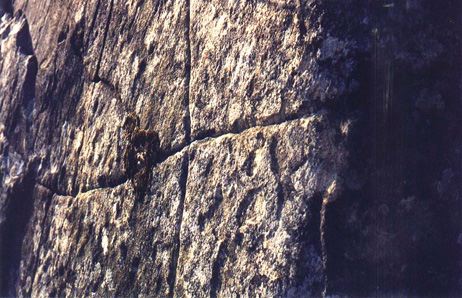
Even up close, the wall appears to be constructed of huge stones, carved and fitted with the most impressive masonry skill. The joints are perfect and are even beveled.
Sue and I were intrigued by the story and trusted the sincerety of our informant. However, the hills of Oklahoma are full of strange stories and not all of them are true. We figured the worst that could happen was that we'd have a nice Sunday in the mountains. After more than three hours of driving, we found a house that fit the Colbert man's description. We knocked on the door and were invited in by a 92 year old resident of the area. The hill folk of Oklahoma are a warm, hospitable people but the old gentleman could not recall hearing of any tablets, though he did know much of what had occurred locally for most of the 20th century. He told us of numerous places where rare flints were to be found and mentioned an "old furnace" that a big timber company had pushed down with bulldozers. His granddaughter graciously drove us up the mountain roads to places her grandfather mentioned and which she had explored as a girl. She pointed out the vicinity of two caves in the steep bluffs but warned of the swarms of rattlesnakes up there this time of year. We returned to our own vehicle and went back to see if we could find any traces of the "little people."
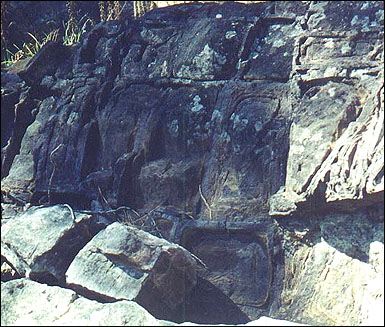
Deterioration of the wall face has revealed something unexpected. The wall is not made of stones after all. Instead it is constructed of manufactured "cells" that show multiple layers of unknown minerals. This view shows the front of the "cells" exposed.
I went down into the dry river bed filled with massive boulders and managed to climb to what appeared to be a cave. It turned out to be only a deep overhang with no sign of human habitation. As I was climbing back, I ran across the first of the "cell" formations badly eroded. It looked odd but natural. Back on the road I discovered a collection of crudely worked flints which appeared to be "blanks" discarded by arrowhead hunters. It was as we turned the truck to go back down from the crest that Sue said, "Stop and take a look at that block formation." I climbed over charred pine logs to what appeared to be a section of massive wall. Not far from there I found the first section of clearly defined "cells" which seemed to be separating from the dense limestone. They seemed to have been "melted" on some way. They were so dense and black, I was almost sure they were iron. Later I tested a section at home with an industrial magnet but it did not react.
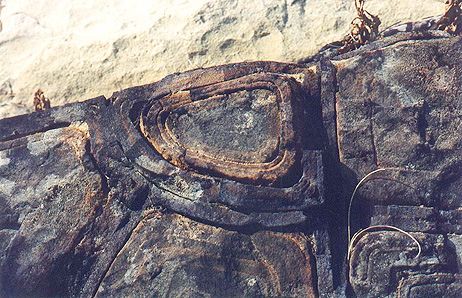
This view was taken from the top of the wall, looking over the edge. Notice the bands of minerals and the precision with which the "cells" fit together.
Sue began photographing the wall and cells while I climbed over two more "parapets" to the summit. What I saw there began to seep into my brain like ice water. Jumbled about in a haphazard fashion were acres of squared, dressed and notched stones. It was eerie standing on those shattered ramparts with all those tumbled stones like a desecrated cemetery. My mind suddenly flashed back to 1979 standing in the ruined streets of Copan in Honduras. The same massive blocks pushed apart by tropical fig trees. Instantly, the realization gripped me that I was standing atop an enormous ruin of cyclopean proportions. Sue struggled up the final wall to join me in the 100 degree evening. It was her turn to be numbed. "This thing is HUGE!" she kept mumbling. By that time we were shaking with heat and exhaustion. I remember asking her over and over, "Are we seeing things? Is this real?"
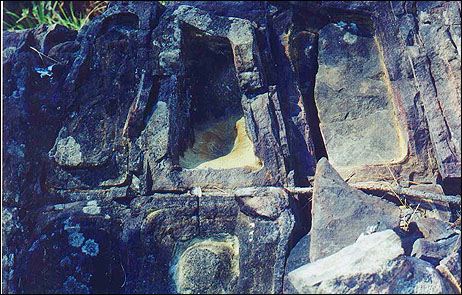
The cells resemble a honeycomb. What type of substance is contained in these cells? Here we can see an opened cell along side an intact one.
Darkness was descending quickly and those snaky places are not where one wants to grope around in the night. We drove away in a state of shock. We were beginning to convince ourselves that it was all a delusion when the film came back from the developer. Our jaws dropped and our minds returned to a proper state of awe and wonder. We showed the pictures and the "cell" sample to staff members and salespeople and asked, "What do you think this is?" The answer was always the same, "I dunno but it ain't natural."
We sent a few black and white jpgs to Frank Joseph at Ancient American for his opinion but as yet have not had a reply. Then we sent some color jpgs to Gary Vey, here at Viewzone. His reply was rapid and enthusiastic, to say the least. We returned for a second expedition and took many more pictures. We also learned that the "Aztecs" had smelted gold up there and that even in historic times, the Choctaws had known of the mine. They used it to trade for salt at Fort Towson up until the first quarter of the 20th century.
I came across an interesting website which detailed the prehistoric copper and iron furnaces in Ohio, Georgia, Virginia, New Mexico and Arizona. One in Ohio is almost identical to the site we found, even to the configuration of the hilltop and it's fortress walls. This ties into what Gene Matlock has said elsewhere in Viewzone about the origins of Coronado's "Gran Quivera." I had written of a renegade Spanish expedition which came as far as eastern Oklahoma before being driven back to die on the Purgatory River. They believed the Tanoan and Caddoan accounts of the seven cities of Cibola, though Coronado thought them a lie. I think the story of Gran Quivera is true but that it had been abandoned long before the 16th century. I am going out on a limb here, but I have no professional reputation to lose. I believe that Sue and I found an ancient Phoenician fortress and furnace and that it may be the remains of one of the "mythical" cities of Cibola. Meanwhile, our investigations are far from over.
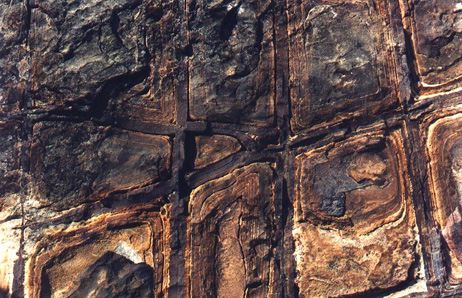
ViewZone welcomes comments and suggestions concerning this research. It appears evident that there is much of our history that has been lost to time and a variety of social and political agendas. We ask your help in seeking the truth. - Editor.
paranormal.about.com/gi/o.htm?zi=1/XJ/Ya&zTi=1&sdn=paranormal&cdn=newsissues&tm=1101&gps=486_681_1676_843&f=10&tt=14&bt=1&bts=1&zu=http%3A//www.viewzone.com/sender.html
very strange looking,funny how they keep this quiet!
by David Campbell
The discovery of the hilltop fortress and furnace came about, it seemed, by casual chance. My wife publishes a little community newspaper distributed in the counties bordering the Red River around Lake Texoma, called TGIF The Weekend Bandit. It is a general interest paper focusing mainly on local events and history. I write a weekly column on history and sometimes feature articles. Since I grew up near Rockwall, Texas, it was of great interest to me to discover that in January 2000 excavation of the mysterious buried wall there had finally been undertaken. I had been obsessed by that wall since childhood.

Only a week or two earlier, I had done an article on Gloria Farley's work on the Heavener Runestone. The rock wall seemed a logical follow up, especially since "runes" had been unearthed there in 1949. In the article, I asked any readers who knew of similar writings or walls to contact me. Following that, I gave a synopsis of Viewzone's expedition to the Purgatory River canyon.
The following Friday, my wife and I returned from our weekly 600 mile distribution route to find a somewhat urgent message from a reader in Colbert, Oklahoma. When I returned his call, he told me of meeting a man while he was hunting arrowheads in the Kiamichi Mountains. This man had found stone tablets with some kind of writing on them and seemed eager to get back to the cave of the "little people" whose skulls and bones were found with the tablets. The caller gave me some extremely vague instructions on getting to the place and no names at all.

Even up close, the wall appears to be constructed of huge stones, carved and fitted with the most impressive masonry skill. The joints are perfect and are even beveled.
Sue and I were intrigued by the story and trusted the sincerety of our informant. However, the hills of Oklahoma are full of strange stories and not all of them are true. We figured the worst that could happen was that we'd have a nice Sunday in the mountains. After more than three hours of driving, we found a house that fit the Colbert man's description. We knocked on the door and were invited in by a 92 year old resident of the area. The hill folk of Oklahoma are a warm, hospitable people but the old gentleman could not recall hearing of any tablets, though he did know much of what had occurred locally for most of the 20th century. He told us of numerous places where rare flints were to be found and mentioned an "old furnace" that a big timber company had pushed down with bulldozers. His granddaughter graciously drove us up the mountain roads to places her grandfather mentioned and which she had explored as a girl. She pointed out the vicinity of two caves in the steep bluffs but warned of the swarms of rattlesnakes up there this time of year. We returned to our own vehicle and went back to see if we could find any traces of the "little people."

Deterioration of the wall face has revealed something unexpected. The wall is not made of stones after all. Instead it is constructed of manufactured "cells" that show multiple layers of unknown minerals. This view shows the front of the "cells" exposed.
I went down into the dry river bed filled with massive boulders and managed to climb to what appeared to be a cave. It turned out to be only a deep overhang with no sign of human habitation. As I was climbing back, I ran across the first of the "cell" formations badly eroded. It looked odd but natural. Back on the road I discovered a collection of crudely worked flints which appeared to be "blanks" discarded by arrowhead hunters. It was as we turned the truck to go back down from the crest that Sue said, "Stop and take a look at that block formation." I climbed over charred pine logs to what appeared to be a section of massive wall. Not far from there I found the first section of clearly defined "cells" which seemed to be separating from the dense limestone. They seemed to have been "melted" on some way. They were so dense and black, I was almost sure they were iron. Later I tested a section at home with an industrial magnet but it did not react.

This view was taken from the top of the wall, looking over the edge. Notice the bands of minerals and the precision with which the "cells" fit together.
Sue began photographing the wall and cells while I climbed over two more "parapets" to the summit. What I saw there began to seep into my brain like ice water. Jumbled about in a haphazard fashion were acres of squared, dressed and notched stones. It was eerie standing on those shattered ramparts with all those tumbled stones like a desecrated cemetery. My mind suddenly flashed back to 1979 standing in the ruined streets of Copan in Honduras. The same massive blocks pushed apart by tropical fig trees. Instantly, the realization gripped me that I was standing atop an enormous ruin of cyclopean proportions. Sue struggled up the final wall to join me in the 100 degree evening. It was her turn to be numbed. "This thing is HUGE!" she kept mumbling. By that time we were shaking with heat and exhaustion. I remember asking her over and over, "Are we seeing things? Is this real?"

The cells resemble a honeycomb. What type of substance is contained in these cells? Here we can see an opened cell along side an intact one.
Darkness was descending quickly and those snaky places are not where one wants to grope around in the night. We drove away in a state of shock. We were beginning to convince ourselves that it was all a delusion when the film came back from the developer. Our jaws dropped and our minds returned to a proper state of awe and wonder. We showed the pictures and the "cell" sample to staff members and salespeople and asked, "What do you think this is?" The answer was always the same, "I dunno but it ain't natural."
We sent a few black and white jpgs to Frank Joseph at Ancient American for his opinion but as yet have not had a reply. Then we sent some color jpgs to Gary Vey, here at Viewzone. His reply was rapid and enthusiastic, to say the least. We returned for a second expedition and took many more pictures. We also learned that the "Aztecs" had smelted gold up there and that even in historic times, the Choctaws had known of the mine. They used it to trade for salt at Fort Towson up until the first quarter of the 20th century.
I came across an interesting website which detailed the prehistoric copper and iron furnaces in Ohio, Georgia, Virginia, New Mexico and Arizona. One in Ohio is almost identical to the site we found, even to the configuration of the hilltop and it's fortress walls. This ties into what Gene Matlock has said elsewhere in Viewzone about the origins of Coronado's "Gran Quivera." I had written of a renegade Spanish expedition which came as far as eastern Oklahoma before being driven back to die on the Purgatory River. They believed the Tanoan and Caddoan accounts of the seven cities of Cibola, though Coronado thought them a lie. I think the story of Gran Quivera is true but that it had been abandoned long before the 16th century. I am going out on a limb here, but I have no professional reputation to lose. I believe that Sue and I found an ancient Phoenician fortress and furnace and that it may be the remains of one of the "mythical" cities of Cibola. Meanwhile, our investigations are far from over.

ViewZone welcomes comments and suggestions concerning this research. It appears evident that there is much of our history that has been lost to time and a variety of social and political agendas. We ask your help in seeking the truth. - Editor.
paranormal.about.com/gi/o.htm?zi=1/XJ/Ya&zTi=1&sdn=paranormal&cdn=newsissues&tm=1101&gps=486_681_1676_843&f=10&tt=14&bt=1&bts=1&zu=http%3A//www.viewzone.com/sender.html
very strange looking,funny how they keep this quiet!






 Happy New Years Everybody!!!
Happy New Years Everybody!!!
